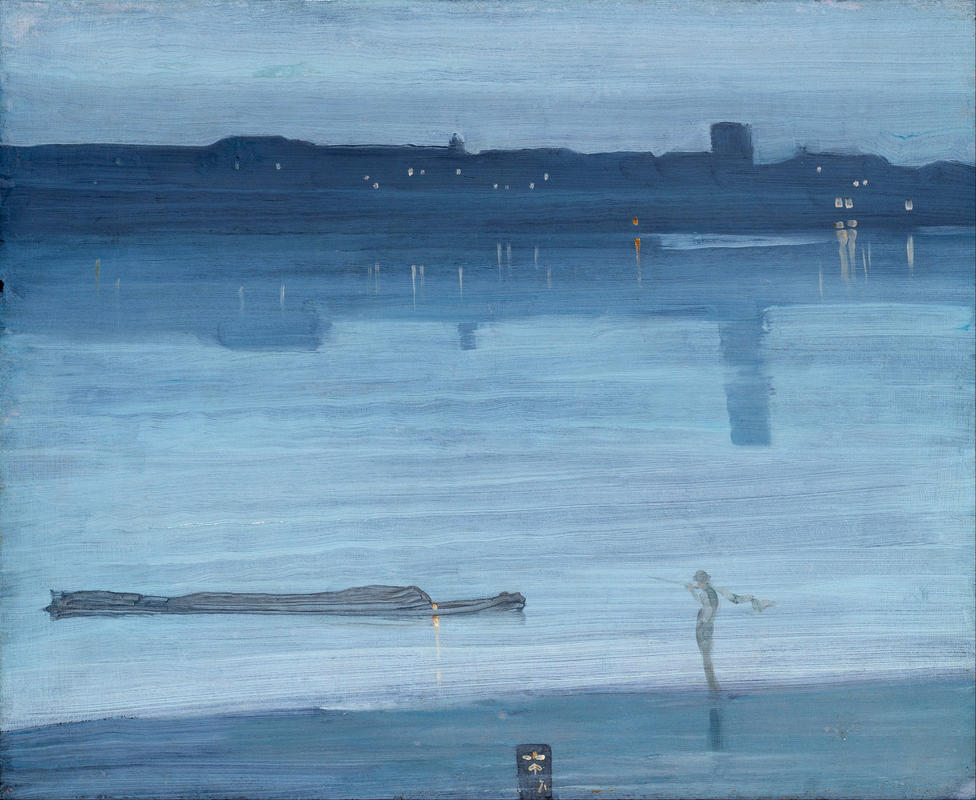More about Nocturne: Blue and Silver - Chelsea

Contributor
A series of nocturnes brought a lot of frustration and heartache to American painter James Abbot McNeill Whistler. Why couldn’t people just enjoy art for the sake of it?
Between the 1870s and mid-1890s, Whistler worked on a series of landscape paintings of the Thames river in London. Nocturne: Blue and Silver – Chelsea is the first Nocturne in the series of landscapes by the infamously misunderstood American artist. These abstract, nocturnal visions went against the contemporary fashion of painting and fell in with the mantra of “Art for art’s sake.”
This painting might well have been a view from Whistler's couch, as the artist had a home in Chelsea, and across from it were the banks of the Thames. The inspiration behind Nocturne: Blue and Silver – Chelsea came with Whistler’s arrival to Westminster via steamer one evening in August of 1871. Whistler used the musical term "nocturne" to title his paintings, believing music to be the poetry of sound. In music, a nocturne is a composition, typically for piano, that is meant to be evocative of the feelings of nighttime. Nocturnes tend to be somewhat pensive, and that rightly sums up Whistler's series. What a nocturne painting represents is dependent on who is looking at it, Whistler once told a judge.
This didn’t play well in the art world. The painting’s lack of detail verging on abstraction was an apparent insult to the city of London. Stomping through the artistic fashion scene were the Pre-Raphaelites, and Whistler’s abstract images did not cut it with them. Famous Whistler hater John Ruskin criticized Whistler for asking for “two hundred guineas for flinging a pot of paint in the public’s face.” Ooouuch! Ruskin treated Whistler as though he painted poo on canvas. Meanwhile, the painting depicts an ordinary scene of a fisherman standing on the banks of Battersea, London, all but evaporating amid the elements of nature (air, water, sand). Whistler opted to go against convention because he wanted to paint poetic scenes of “palaces in the night.” Can you really blame a guy for wanting to transform the mundane of the urban world into visual gold? I say nay! Paint on, Whistler, for your palaces have a place in this world.
Sources
- Corbett, David Peters, The world in paint: modern art and visuality in England, 1848-1914. Manchester: Manchester University Press, 2004.
- Fawcet, Kirstin, “See 19th-century London through the eyes of James McNeill Whistler, one of America’s greatest painters,” Smithsonian Magazine, May 8, 2014. Accessed March 18, 2020. https://www.smithsonianmag.com/smithsonian-institution/see-19th-century-
- Freeman-Attwood, Jessica, “The divine messages of a Victorian spiritualist’s drawings,” Hyperallergic, September 7, 2016. Accessed March 18, 2020. https://hyperallergic.com/321452/the-divine-messages-of-a-victorian-spi…
- Grovier, Kelly, “Silver: The color of betrayal?” BBC, November 2, 2018. Accessed March 18, 2020. http://www.bbc.com/culture/story/20181102-silver-the-colour-of-betrayal
- Heardman, Adam, “Acquainted with the night: how Whistler’s Nocturnes changed America,” Mutual Art, July 11, 2019. Accessed March 18, 2020. https://www.mutualart.com/Article/Acquainted-With-the-Night--How-Whistl…
- Noble, Will, “10 masterpieces of London you can see in London,” April 6, 2017. Accessed March 18, 2020. https://londonist.com/london/art-and-photography/masterpieces-of-london…
- Ono, Ayako Japonisme in Britain: Whistler, Menpes, Henry, Hornel and nineteenth-century Japan. New York: Routledge Curzon, 2003.
- Richman-Abdou, Kelly, “5 facts about James McNeill Whistler, an American artist who made ‘Art for art’s sake,’” My Modern Met, March 9, 2020. Accessed March 18, 2020. https://mymodernmet.com/james-mcneill-whistler-facts/
- Wullschlager, Jack, “Whistler and the Thames, Dulwich Picture Gallery, London - review,” Financial Times, October 19, 2013. Accessed March 18, 2020. https://www.ft.com/content/3cf7420e-34ee-11e3-8148-00144feab7de
Featured Content
Here is what Wikipedia says about Nocturne: Blue and Silver – Chelsea
Nocturne: Blue and Silver – Chelsea is a painting by James McNeill Whistler, completed in 1871. It is the earliest of the London Nocturnes and was conceived on the same August evening as Variations in Violet and Green. The two paintings were exhibited together at the Dudley Gallery.
Check out the full Wikipedia article about Nocturne: Blue and Silver – Chelsea












